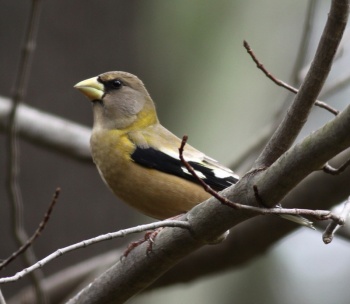- Hesperiphona vespertina
Coccothraustes vespertinus
Identification
18–21·5 cm (7-8½ in)
- Short black tail
- Black wings
- Large pale bill
Male
- Bright yellow forehead and body
- Brown head
- Large white wing patch
Female
- Olive brown
- Greyer on the underparts
- White wing patches
Variation
Western birds on average are longer-billed, have narrower yellow on forehead, and different calls.
Distribution
Canada and the western mountainous areas of the United States and Mexico.
The migration of this bird is variable; in some winters, it may wander as far south as the southern U.S.
The range of this bird has expanded far to the east in historical times, possibly due to plantings of Manitoba maples and other maples and shrubs around farms and the availability of bird feeders in winter.
Taxonomy
A large finch. Some authorities now place this species in Coccothraustes[1], the same genus as the Hawfinch of Eurasia.
Subspecies
There are 3 subspecies:
- H. v. brooksi:
- H. v. vespertinus:
- East-central Canada (Alberta to New England); winters to south-eastern US
- H. v. montanus:
Habitat
The breeding habitat is coniferous and mixed forest.
Behaviour
Diet
These birds forage in trees and bushes, sometimes on the ground. They mainly eat seeds, berries and insects. Outside of the nesting season, they often feed in flocks. Sometimes, they will swallow fine gravel for the salts.
Breeding
The nest is built on a horizontal branch or in a fork.
References
- Clements, J. F., P. C. Rasmussen, T. S. Schulenberg, M. J. Iliff, T. A. Fredericks, J. A. Gerbracht, D. Lepage, A. Spencer, S. M. Billerman, B. L. Sullivan, M. Smith, and C. L. Wood. 2024. The eBird/Clements checklist of Birds of the World: v2024. Downloaded from https://www.birds.cornell.edu/clementschecklist/download/
- The Sibley Guide to Birds
Recommended Citation
- BirdForum Opus contributors. (2025) Evening Grosbeak. In: BirdForum, the forum for wild birds and birding. Retrieved 18 May 2025 from https://www.birdforum.net/opus/Evening_Grosbeak
External Links
GSearch checked for 2020 platform.1







